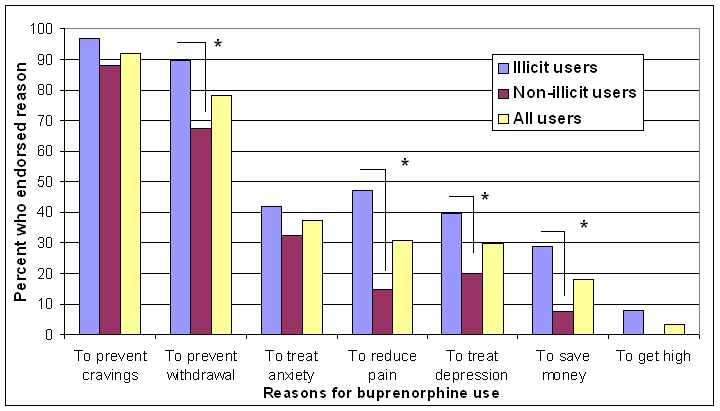The previous edition of STASH highlighted the complex relationship between subjective distress and substance abuse. We continue to explore this theme in this week’s STASH by reviewing a new study about the illicit use of buprenorphine, an opioid analgesic, among opioid-dependent treatment seekers. Schuman-Olivier and colleagues (2010) explored whether treatment seekers typically use buprenorphine as an attempt to attain euphoria or as self-treatment for pain and symptoms of opioid dependence. Additional research goals were to describe the prevalence of illicit buprenorphine use and to explore how illicit buprenorphine use decreases as people become engaged in comprehensive substance abuse treatment.
Methods
- An outpatient addiction service in New England served as the study site. All participants met DSM-IV criteria for opioid dependence.
- Stage 1 participants included 44 individuals seeking outpatient treatment with buprenorphine (i.e. “new intakes”) and 34 patients already receiving outpatient treatment with buprenorphine (i.e. “existing patients”). Participants reported, on average, 12.7 years of opioid use.1
- Among other measures not described here, participants completed: the Buprenorphine Beliefs and Behaviors Questionnaire, to measure reasons for buprenorphine use (e.g., to get high, to save money, to reduce pain); and the Illicit Buprenorphine Use Questionnaire, to measure whether participants used buprenorphine illicitly (e.g., by buying illicit “street” buprenorphine).
- For Stage 2, researchers administered the same surveys to 42 of the Stage 1 participants three months later.2
Results
- The Stage 1 past 90-day prevalence of illicit buprenorphine use was 49%. Most patients who used buprenorphine illicitly (61%) were new intakes – those who did not yet have access to a doctor’s prescription.
- Patients reported that they used buprenorphine to reduce distress, not to get high. As Figure 1 indicates, the most common reasons for buprenorphine use among all Stage 1 participants were to self-treat opioid dependence, anxiety, and pain. Illicit users were more likely than non-illicit users to use buprenorphine to prevent withdrawal, reduce pain, treat depression, and save money (all χ2 > 3.50, all p ≤ .05).
- At Stage 1, only 32% of existing patients, compared with 61% of new intakes, reported illicit buprenorphine use during the past 90 days (χ2 = 6.46, p < .05). Among completers of Stage 2, illicit buprenorphine use dropped by 70% from Stage 1 to Stage 2 (repeated measures χ2 = 4.89, p < .05).

Figure. Percent of participants in each group (illicit users, non-illicit users, and all users) who endorsed each potential reason for buprenorphine use. Asterisks indicate significant differences between illicit users and non-illicit users, as revealed by chi-square analysis. Based on data reported by Schuman-Olivier et al. (2010). Click image to enlarge.
Limitations
- This study had a small sample size, which limits the power to detect significant differences; it also employed a homogenous sample obtained from one clinic, which limits conclusions about the generalizability of the findings.
- The follow-up time frame was only 3 months, which precludes understanding whether and how people use buprenorphine to prevent long-term relapse.
- These data, collected at intervals separated by 3 months, do not speak to the effectiveness of buprenorphine in self-treatment for short-term states such as cravings and depressed moods.
Discussion
About half of patients in this sample used buprenorphine illicitly at baseline. The fact that these individuals were most likely to use buprenorphine to self-treat their opioid dependence, pain, and depression counters the notion that most people use this drug illicitly to mimic the euphoric effects of opiates. Further, these data reveal that once engaged in an outpatient addiction treatment setting, and given a legal prescription for buprenorphine, most patients tend to reduce their illicit use of this drug. Overall this study suggests that people turn to buprenorphine to deal with recurrent feelings of distress and symptoms of opioid dependence, and that they are less likely to do so illicitly when given an affordable prescription. Future studies using more frequent assessments (e.g., ecological momentary assessment) might shed light on the effectiveness of buprenorphine for alleviating short-term distress. We suggest that policy makers take these data and the results from larger future studies into consideration when making decisions about the prescription use of buprenorphine as part of comprehensive substance abuse and mental health treatment programs.
–Heather Gray
What do you think? Please use the comment link below to provide feedback on this article.
References
Schuman-Olivier, Z., Albanese, M., Nelson, S. E., Roland, L., Puopolo, F., Klinker, L., & Shaffer, H. J. (2010). Self-treatment: Illicit buprenorphine use by opioid-dependent treatment seekers. Journal of Substance Abuse Treatment, 39, 41-50.
________________
[1] New intakes did not differ from existing patients on any demographic variables measured (e.g., gender composition, salary, age). However, new intakes reported greater depression severity and more frequent lifetime benzodiazepine use at Stage 1.
[2] Researchers chose to track the first three-quarters of participants who were eligible for Stage 1.





John French June 9, 2010
I have always understood that buprenorphine per se is very difficult to obtain in the U.S., and that “buprenorphine” clinics are actually dispensing Suboxone, which is a combination of buprenorphine and naloxone. The drug reactions are immensely different depending on mode of ingestion. Suboxone has reduced opioid effect when injected iv, because it is counterbalanced by the naloxone. For this reason it is absolutely necessary to specify both the actual drug used, and the mode of ingestion.
If, in fact, the original article discussed these issues, then it is incumbant on BasisOnline to modify its discussion.